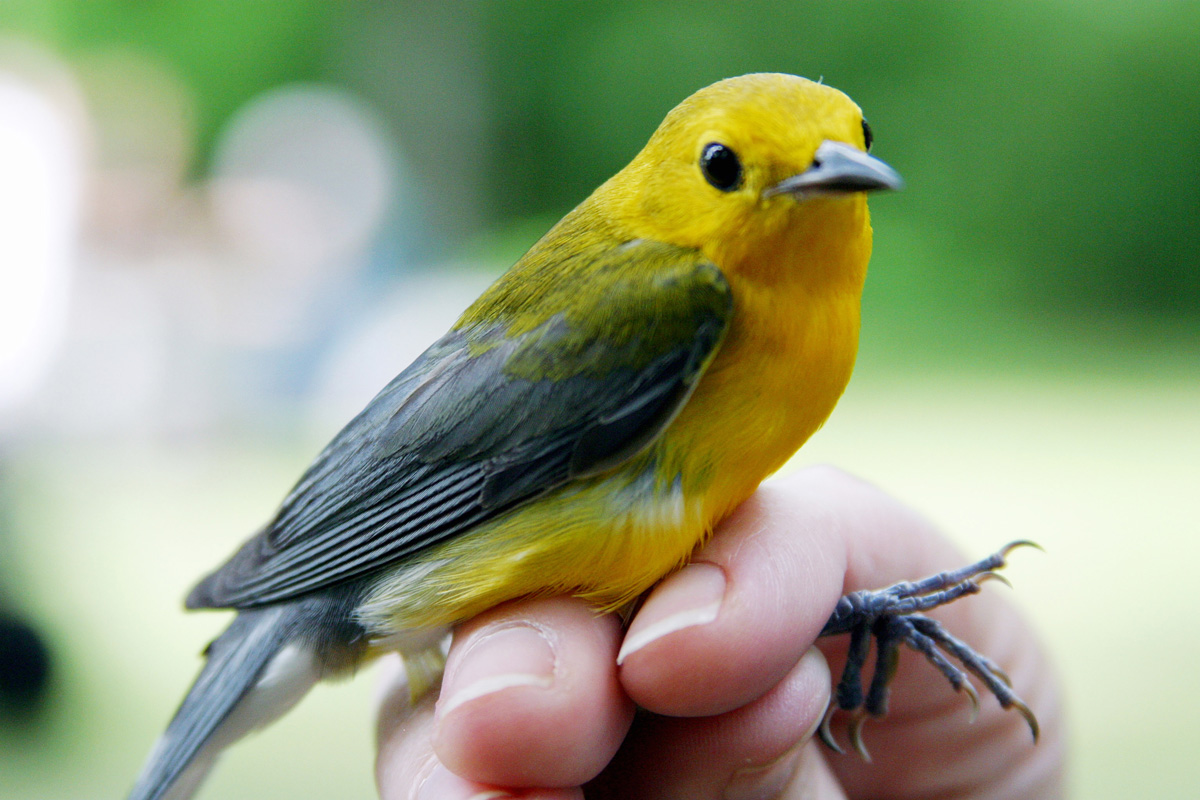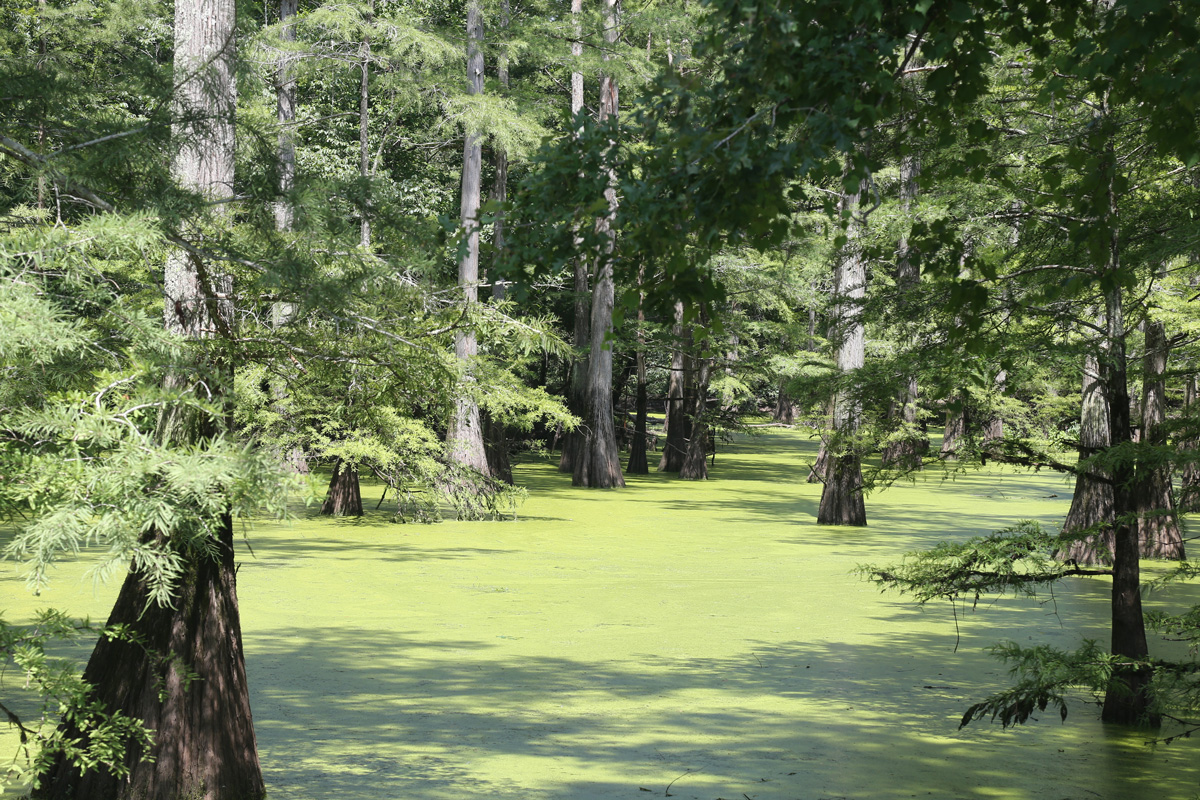Bird’s the Word
What’s Good for the Duck is Good for the Warbler.
By Chris Hancock
B irds have a special capacity to capture our attention. Their songs punctuate our days, and flashes of color flitting through trees catch our eyes. The gravity-defying magic of their flight has mystified us for millennia, inspiring art, literature and innovations that have taken us to the skies.
Arkansas hosts an impressive variety of bird species, but not all garner the same attention. Perhaps our most talked-about birds are ducks, particularly mallards, which have historically wintered here. Ducks and duck hunting are part of Arkansas culture, past and present.
To the alarm of hunters and the communities that host them, the conversation about ducks is increasingly about their decline. Data from the Arkansas Game and Fish Commission (AGFC) shows a substantial decrease in mallards over the past decade.
Two primary culprits are to blame: climate change and habitat loss. Ducks migrate south when northern wetlands freeze, but milder winters mean fewer ducks need to travel as far south.
“When you have conditions that are not that bad farther north … a lot of birds aren’t going to make the complete migration to Arkansas,” says Dr. Than Boves, professor of ecology at Arkansas State University. “Climate change is driving ducks to go to different places.”
“If you wanted to create a state
with as many bird species as possible,
you would create a state
with as many habitats as possible—
and that’s what we have.”
– Dr. Than Boves
Arkansas’s changing precipitation patterns and the availability of bottomland hardwood forest habitat also play a role. “We may get the same annual precipitation, but in different patterns,” said Allison Fowler, assistant chief of wildlife management for AGFC. “We may get a lot all at once, and then we’ll have dry periods, and wetlands can dry up.”
Arkansans have little control over climate-driven changes in migration, but they can play a role in habitat conservation. “It comes down to habitat,” Fowler said.
When ducks migrate to Arkansas, a lack of appropriate habitat, like bottomland hardwood forest, can force them to winter elsewhere. “Bottomland forests face challenges that could continue to reduce duck populations, especially mallards,” Boves said.
Ducks favor flooded bottomland hardwood forests for cover, water, and their favorite food — acorns, which can provide up to 50% of their diet. However, these forests have shrunk substantially.
“We’ve lost about 80% of our bottomland forests,” Boves said. “The remaining forest is really valuable.”
Beyond ducks, these forests are essential for other bird species. “Ducks happen to be one of the more popular species out of many that depend on this habitat,” Fowler said.
“Many species use the same habitat that we consider ideal for duck hunting,” Boves said. Some of which “are declining or at least of conservation concern.”
“We’ve already lost species tightly linked to bottomland forests,” Boves said. The ivory-billed woodpecker is believed extinct. The Bachmann’s warbler was declared extinct in 2021. “Both of these were bottomland forest specialists that lost habitat.”
The protonotary warbler depends on this habitat and has experienced a decline in recent decades. It is considered an indicator species, meaning its presence indicates the overall health of the ecosystem.
“If you have prothonotary warblers, you probably have a good bottomland forest,” Boves said.
If absent or declining, “there’s probably something wrong with either the hydrology or the ecosystem on a broader scale.”
This “iconic swamp species is bright yellow with a distinct call,” Fowler said.
It winters in South America. “And they come to Arkansas in the spring and summer to breed,” Boves said. They’re switching places with the waterfowl, but they use the same habitat, just at different times of the year.
Expanding bottomland hardwood forests is critical, but reforestation takes time. The priority is conserving existing forests. The AGFC is hard at work to manage this habitat on its lands.
“AGFC only manages so many acres of land, and we do our best,” Fowler said, “but it’s really just a drop in the bucket statewide.”
The majority of remaining bottomland hardwood forests are privately owned. Landowners play an invaluable role in conservation. The AGFC and other agencies offer programs to help landowners manage these rare habitats.
“We’re targeting certain landscapes and providing incentives for landowners to restore habitats,” Fowler said. “Biologists can come to see your property, talk through management options, create management plans and help you get signed up for programs to fund that work.”
Flooding management is another key factor. Forests are often flooded to produce habitat conducive to duck hunting, but extended flooding can damage forests.
“Oaks can handle temporary flooding, but when they’re flooded for too long, it compromises the health of the trees and prevents the next generation of oak saplings from starting, which compromises the long-term health of the forest,” Boves said.
AGFC works to mimic natural flooding and draining cycles. Private landowners also play a role in responsible flooding management to conserve forests and sustain waterfowl and other species.
Balancing conservation with economic interests is possible. Boves points to cerulean warbler conservation as an example. “We’ve found ways to use forests for economic purposes, like timber harvest, while also maintaining habitat for Cerulean warblers and other species.”

Birds like the protonotary warbler and bottomlands like Cut-Off Creek WMA are vital to a thriving ecosystem's delicate balance. Photography courtesy of Arkansas Game and Fish Commission

The economic impact of duck hunting, which depends partly on bottomland hardwoods, is well known. “It’s definitely an economic driver here in Arkansas,” Fowler said.
But mallards aren’t the only birds contributing to the economy. Other species that depend on the same habitat as waterfowl provide ecosystem services like seed dispersal, fertilization and pest control. By consuming insects, they reduce crop damage and lower pesticide use.
Without birds “you would have a lot more insects bugging you,” Fowler said.
Conservation of species like the prothonotary warbler can also drive economic impact through ecotourism by attracting birders who spend money in local communities on hotels, restaurants, equipment and other expenses.
A U.S. Fish and Wildlife Service study found that the number of people who birdwatch is increasing, including among younger people. Various apps for identifying and logging bird sightings have gained popularity.
“There are more people who birdwatch than people who hunt or fish,” Fowler said.
Arkansas has a unique opportunity to conserve and expand unique habitats to support the continued economic impact of duck hunting while also seizing new economic opportunities presented by the growth of birding.
“If you look at the country as a whole, you’ll see that recreational wildlife watching is actually worth more economically than hunting now,” Boves said. “Hunting is still incredibly valuable to the state and incredibly popular. I would guess that hunting is still probably outpacing wildlife watching in Arkansas. And that’s maybe partly the culture, but it’s also partly the amount of effort that’s been put into making it a destination for bird watchers.”
Arkansas can benefit from its unique natural resources through strategic conservation and ecotourism marketing. Its mild climate, location in the path of many migratory species, and diversity of habitats make it welcoming to many species.
“With a variety of habitats, you get a variety of birds,” Fowler said.
“If you wanted to create a state with as many bird species as possible, you would create a state with as many habitats as possible,” Boves said, “And that’s what we have.”



